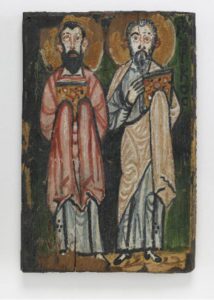
More than 100 years after they were first on view to the public in museum-founder Charles Lang Freer’s Detroit home, two rare antique biblical manuscripts will return to view at the Freer Gallery of Art Nov. 16. The Washington Codex–one of the oldest manuscripts of the four Gospels in the world–as well as an ancient parchment volume of Deuteronomy and Joshua will be on view through Feb. 16, 2014, in the unexpected setting of James McNeill Whistler’s blue-and-gold Peacock Room.
The Washington Codex, also known as the Codex Washingtonensis or Freer Gospels, is the third-oldest parchment manuscript of the gospels in the world, dating from the fourth to fifth centuries. The scriptures of Deuteronomy and Joshua are substantially complete texts from the Old Testament and date from the same period. Painted wooden covers, designed to protect the Gospels and decorated with representations of the four Evangelists, will also be on view. (More on Freer’s collection of Biblical manuscripts)
_______________________________________________________________________________________________________________________
Washington Manuscript III: The Four Gospels (Codex Washingtonensis) Egypt, late 4th–early 5th century Ink on parchment Gift of Charles Lang Freer Freer Gallery of Art, F1906.274 Courtesy Freer Gallery of Art
________________________________________________________________________________________________________________________
Freer purchased the manuscripts in 1906 in Giza, Egypt, and later organized and underwrote significant early biblical scholarship. While researching their cultural context and physical structure, it was discovered that the Washington Codex contains a passage not found in any other biblical text-a segment at the end of the Gospel of Mark known as the Freer logion (a logion is a saying attributed to Jesus), which will be viewable during the exhibition.
However, Freer was mainly interested in aesthetic beauty and harmonies among the various objects in his collection, regardless of type or origin. In November 1912, he opened his Detroit home to the public and used Whistler’s Peacock Room as a display space to curate his acquisitions, filling the shelves with pottery from the Middle East and Asia, tables of Buddhist sculpture and glass cases containing the Washington Codex and Old Testament manuscripts. Having recently promised his collection to the Smithsonian, the room became a beautiful laboratory where Freer could bring seemingly disparate objects into a visual conversation.
“When Freer chose to exhibit his rare biblical manuscripts in the Peacock Room, he was demonstrating his belief in cross-cultural correspondence,” said Lee Glazer, curator of American art at the Freer Gallery of Art and Arthur M. Sackler Gallery. “Juxtaposing these sacred texts with ceramics and aesthetic decoration underscored Freer’s belief that ‘all works of art go together.'”
Due to their extreme fragility and sensitivity to light, the manuscripts are rarely exhibited, last appearing as highlights of the Sackler’s landmark exhibition in 2006, “In the Beginning: Bibles Before the Year 1000.” For this reason, the opening of the Peacock Room shutters on the third Thursday of each month will be suspended while the bibles are on view, resuming on Feb. 20, 2014.
__________________________
The Freer Gallery of Art, located at 12th Street and Independence Avenue S.W. and the Arthur M. Sackler Gallery, located at 1050 Independence Avenue S.W., together house the nation’s collection of Asian art on the National Mall in Washington, D.C. Hours are from 10 a.m to 5:30 p.m. every day except Dec. 25, and admission is free. The galleries are located near the Smithsonian Metrorail station on the Blue and Orange lines. For more information, the public may call (202) 633-1000 or visit www.asia.si.edu.
_______________________________
Source: Press release of the Freer Gallery of Art
Cover Photo, Top Left: Detail, Saint Mark and Saint Luke; right cover of Washington Manuscript II: The Four Gospels (Codex Washingtonensis) Egypt, Byzantine period, 7th c. Encaustic painting on wooden panel Gift of Charles Lang Freer Freer Gallery of Art, F1906.298 Courtesy Freer Gallery of Art
________________________________________________________________________________________________________________________
Read about the most fascinating discoveries with a premium subscription to Popular Archaeology Magazine. Find out what Popular Archaeology Magazine is all about. AND MORE:
 Popular Archaeology’s annual Discovery edition is a selection of the best stories published in Popular Archaeology Magazine in past issues, with an emphasis on some of the most significant, groundbreaking, or fascinating discoveries in the fields of archaeology and paleoanthropology and related fields. At least some of the articles have been updated or revised specifically for the Discovery edition. We can confidently say that there is no other single issue of an archaeology-related magazine, paper print or online, that contains as much major feature article content as this one. The latest issue, volume 2, has just been released. Go to the Discovery edition page for more information.
Popular Archaeology’s annual Discovery edition is a selection of the best stories published in Popular Archaeology Magazine in past issues, with an emphasis on some of the most significant, groundbreaking, or fascinating discoveries in the fields of archaeology and paleoanthropology and related fields. At least some of the articles have been updated or revised specifically for the Discovery edition. We can confidently say that there is no other single issue of an archaeology-related magazine, paper print or online, that contains as much major feature article content as this one. The latest issue, volume 2, has just been released. Go to the Discovery edition page for more information.
Subscription Price: A very affordable $5.75 for those who are not already premium subscribers of Popular Archaeology Magazine (It is FREE for premium subscribers to Popular Archaeology). Premium subscribers should email [email protected] and request the special coupon code. Or, for the e-Book version, it can be purchased for only $3.99 at Amazon.com.





